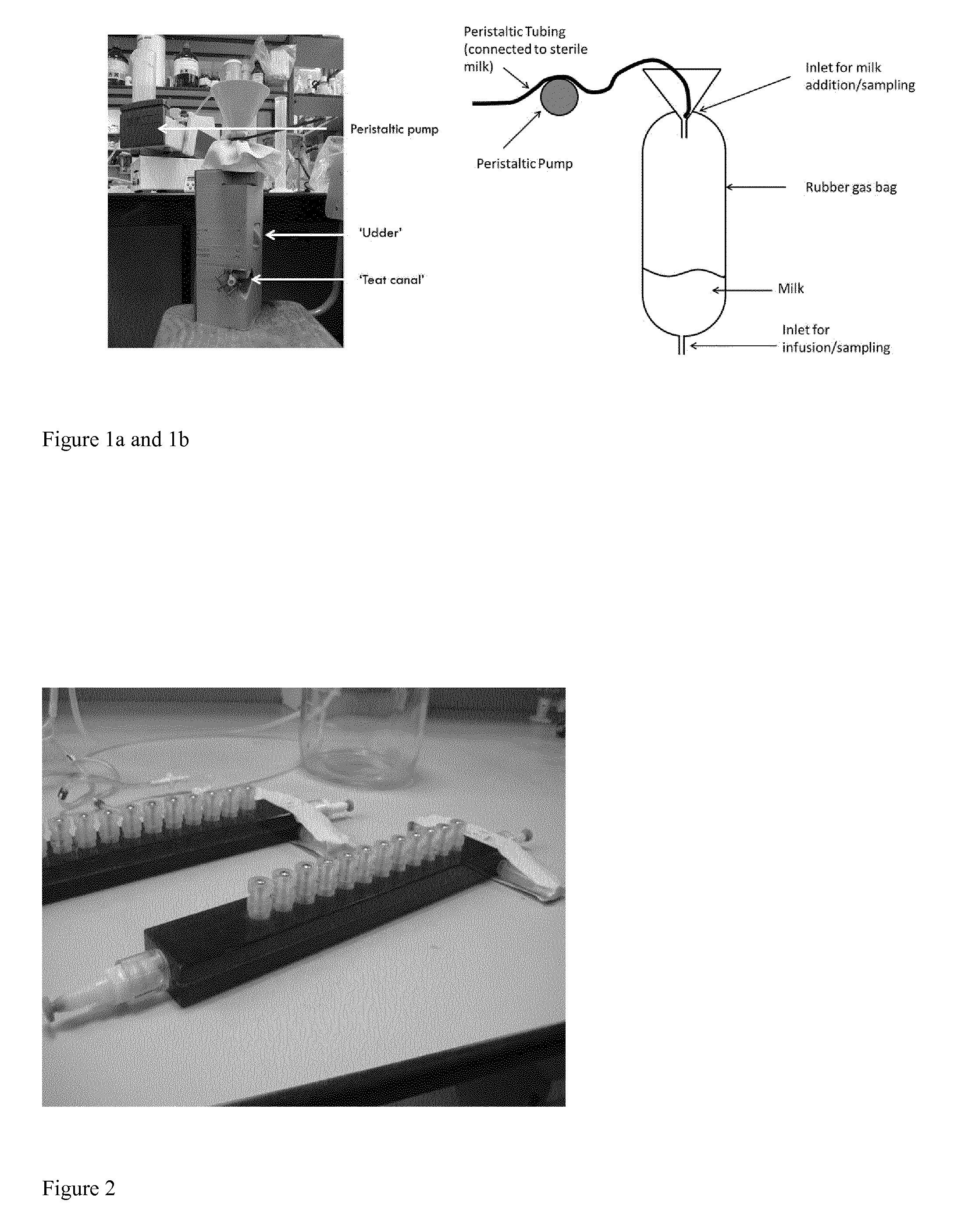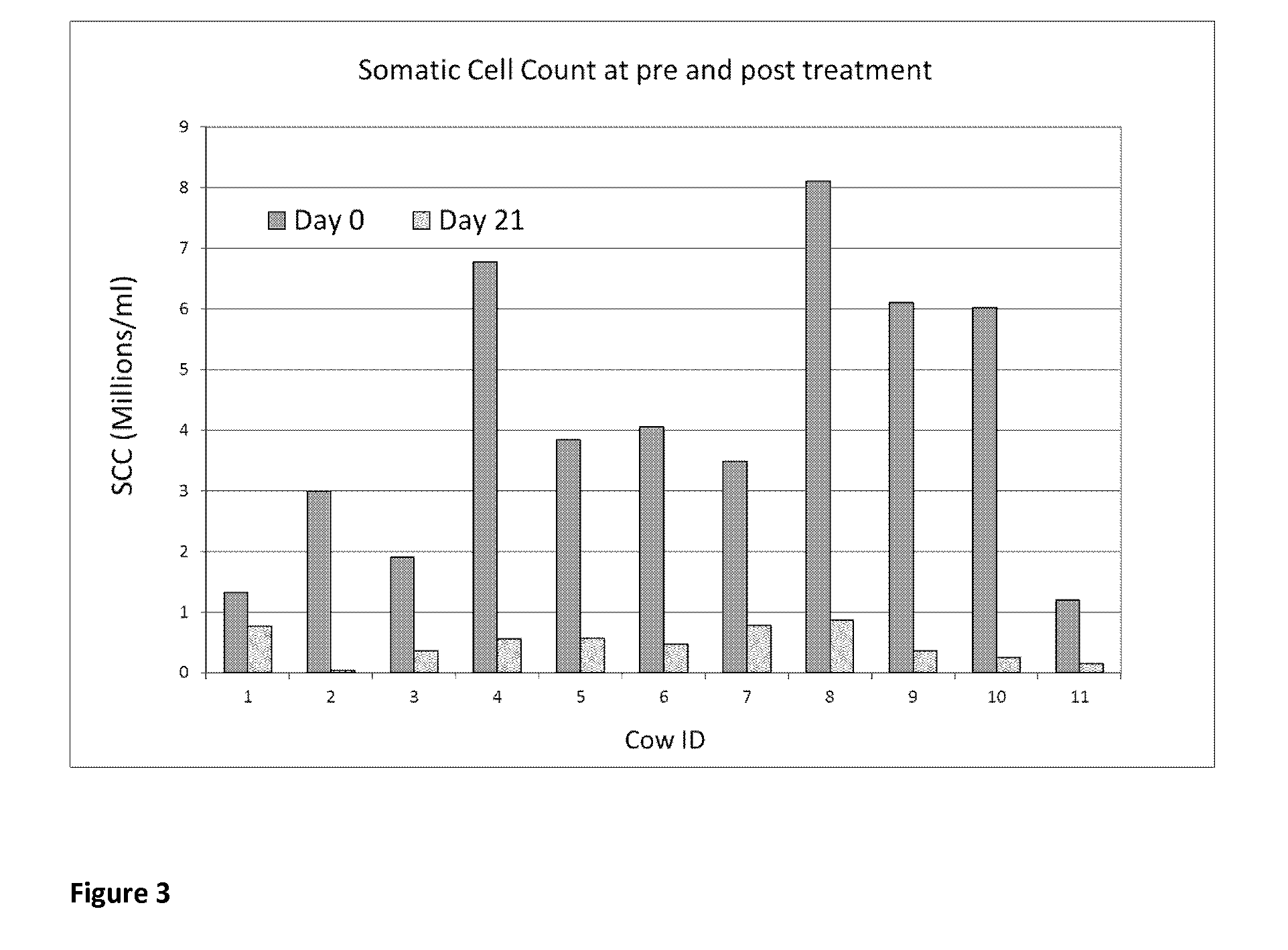Moreover, the stage of
lactation will have an effect (teats can crack and become damaged as the
lactation cycle progresses) and the number of lactations undergone by an animal will dictate the likelihood of
inflammation (though not necessarily infection).
The requirement to discard, or at least not sell, milk during antibiotic treatment is a significant additional economic cost to the milk producer, associated with mastitis.
Antimicrobial-containing milk is discarded, at a large cost to the farmer, as it is not suitable for use in post-
processing.
Moreover,
nisin residues in milk may also inhibit
starter cultures for cheese and yogurt production and thus interfere with
downstream processing of milk in a manner similar to antibiotics.
It has been found, for example, that
nisin residues in milk could lead to some interference with cultured dairy products (certain cheeses, yogurts) if a high proportion of animals are treated at any one time.
Nisin use was also shown to elevate the
somatic cell count of the animals during treatment, a serious drawback when
payment to the farmer is based on SCC levels.
In addition to concerns about the development of
antibiotic resistance with respect to
human medicine, a major problem in dairy husbandry is antimicrobial resistance in animals, associated with historical antibiotic usage.
Microbial resistance to
antibiotic drugs will become prevalent upon repeated usage, such that any particular antibiotic will become completely ineffective as a therapy at some point—this is widely recognised as a critical and urgent challenge in both human and
veterinary medicine.
As such, they are much more difficult to treat.
Firstly, the antibiotics will cause an initial decrease in SCC, indicating the killing of the
bacteria.
However, the antibiotic will not access the cells in the epithelial lining.
Treatment of such cases is particularly difficult, as repeated use of the antibiotic results in a
bacterial strain that, due to repeated contact with the
drug, is highly likely to develop resistance characteristics.
Treatment of these types of cases has a poor chance of success, even using the most potent of current antibiotic therapies.
At this stage, it will normally be economically unfeasible to keep the animal, and thus the animal would be culled and the farmer would replace the animal at a cost of >1,000 ($1,300)
The economic costs associated with the occurrence of mastitis thus include: reduction of
milk yield, loss of income due to poorer quality milk produced, veterinarian charge, antibiotic prescription, loss of income due to withholding of milk and replacement of culled animals.
Chronic infections will often result from this situation, seriously impairing the health of the patient.
This is a particular risk during
surgical procedures, where body cavities are open to the environment.
It also poses great problems for the drinks industry, and is a typical
organism found on beer lines, and is the cause of beverage spoilage.
These applications are unsuitable for use in an antimicrobial therapy within the body of a human or an animal, due to the damage caused by elevated concentrations (0.15% upwards) of
peroxide to
mammalian tissue.
Furthermore, elevated concentrations of
hydrogen peroxide have been shown to impede healing and lead to scarring of damaged tissue (in, for example wounds and burns) because it destroys newly formed cells.
Hypoiodite (IO−), produced as a result of the reaction between
peroxide, a
peroxidase enzyme and
iodide can be bacteriocidal to
Gram-negative microorganisms when they are grown in laboratory media, but the literature teaches that this approach will be ineffective under physiological conditions as the production of IO− is inhibited by the presence of
thiocyanate, at concentrations of the latter compound normally found in
saliva, milk and other physiological settings (Klebanoff et al., 1967, J Exp Med 1967 126(6):1063-78; Tenovuo et al.
Moreover, the presence of
catalase in bacteria makes solutions of
hydrogen peroxide at a concentration below 3% less effective, even against
gram positives.
A review of the use of
hydrogen peroxide in a variety of studies on wounds found that “In conclusion,
hydrogen peroxide appears not to negatively influence
wound healing, but it is also ineffective in reducing the bacterial count” (Drosou et al., 2003, Wounds; 15(5).
The prior art thus teaches that use of compositions containing less than 3%
hydrogen peroxide for bacteriocidal purposes would be ineffective for
in vivo wound applications.
Its limitations are well characterised as it reacts poorly with organic material, and can be toxic if in the
blood stream.
This is supported by prior art reports describing: (i) poor effectiveness in killing
Gram-positive organisms (‘Due to mainly bacteriostatic effect of the
system it is not possible to disguise poor milk quality’, Guidelines for the Preservations of
Raw Milk by the use of the
Lactoperoxidase System, CAC / GL 13-1991, WHO “
Lactoperoxidase System of
Raw Milk Preservation—Call for data, 2005; Reiter and Harnulv 1984); (ii) transitory bacteriostatic effects wherein the bacteria once more start to proliferate after a short
delay (Ishido et al., 2011 Milchwissenschaft 66 (1) 2011; Thomas et al., 1994, Infection and
Immunity, Vol 62, No. 2 p 529-535; Marks et al., 2001 J Appl. Micro. 91, 735-741; Kamau et al., 1990 Appl and Env. Micro. Vol. 56, No. 9; McLay et al., 2002, Int Jour of Food micro, 73, 1-9); and (iii) inability to eradicate bacteria growing in biofilms (Dufour et al., Journal of Food Protection, 67 (2004), pp 1438-1443; Abbeele et al., 1996, Int Rech Sci Stomotol Odontol 39 (1-2):57-61).
One would expect that the IO− compound would not be effective at completely killing the pathogens and curing a mastitis infection, based on published data.
The prior art, however, is incorrect with respect to the products of the reaction between low (<0.5%) concentrations of
hydrogen peroxide and
iodide, when this reaction takes place in the absence of a
peroxidase enzyme.
Others have described the necessary use of immobilized enzymes to produce OSCN−, which is a configuration unsuited for use in a mastitis therapy.
In US 2012 / 0021071 A1, however, the applicants acknowledge the need for additional extraneous compounds to enable
biofilm removal as OSCN− itself was insufficient for this purpose.
Antibiotic treatment for either condition can lead to serious
drug resistance, minimising their effectiveness.
Drug delivery is a big problem for CF sufferers as the antibiotic cannot efficiently transverse the
lung membrane to where it is required.
This leads to problems wherein resistance to the
drug, through the introduction of sub-inhibitory concentrations, may become a serious issue.
Burns patients, or patients with
open wounds, are extremely susceptible to bacterial infections, notably those due to Staphylococcal or Pseudomonad species of bacteria.
Such use of antibiotics will often lead to resistance to the drug and an ineffective
treatment outcome.
In addition, large numbers of antibiotic treatments each year are due to medical devices that have become infected whilst in use by a patient.
Such biofilms are extremely difficult to treat with antibiotics, due to the poor transfer of the drug across to the inner cells of the
biofilm mass, leading often to even greater levels of tolerance of the biofilms to the antibiotic.
Infection of the
medical device will often require its removal and replacement, to the discomfort of the patient.
Although the infection will often be noted a number of days after installation of the
medical device, it will be typically incurred as the result of bacteria being present very early in the installation.
 Login to View More
Login to View More 


